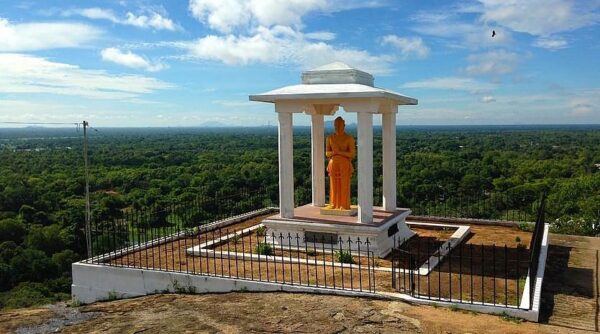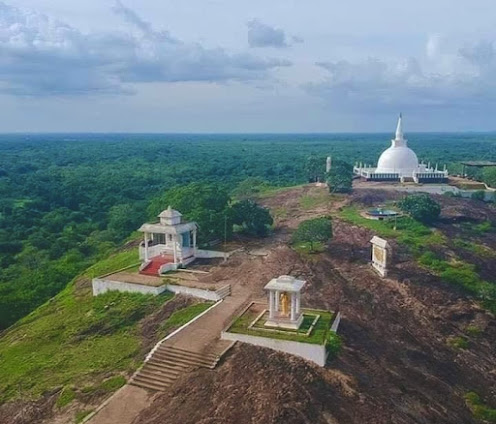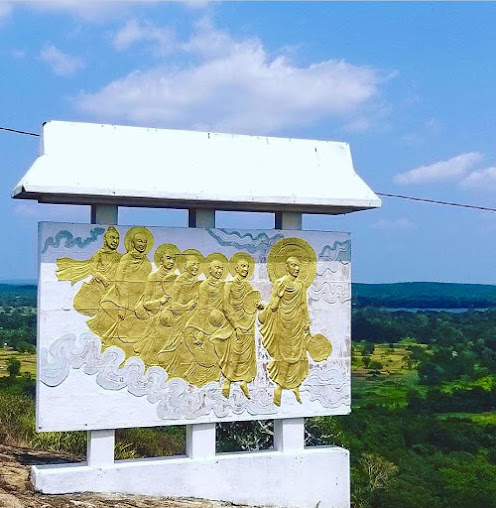Isinbassagala Ruwangiri Rajamaha Viharaya – temple with historical significance – By Arundathie Abeysinghe

 Situated on the summit of a rock plateau, Isinbassagala Ruwangiri Rajamaha Viharaya (“Isinbassagala” meaning “the rock that the sage came from”) is a temple with historical significance. The stupa of the Temple is situated on a rock plateau approximately 160 meters (530 feet) high. Yet, it is not difficult to climb this rocky plateau. The Temple can be seen at a distance, the greatest attraction of the location. According to scholars, the Temple Complex has been constructed by King Devanampiyathissa (250-210 BC), immediately after the introduction of Buddhism to Sri Lanka by *Arhat Mahinda.
Situated on the summit of a rock plateau, Isinbassagala Ruwangiri Rajamaha Viharaya (“Isinbassagala” meaning “the rock that the sage came from”) is a temple with historical significance. The stupa of the Temple is situated on a rock plateau approximately 160 meters (530 feet) high. Yet, it is not difficult to climb this rocky plateau. The Temple can be seen at a distance, the greatest attraction of the location. According to scholars, the Temple Complex has been constructed by King Devanampiyathissa (250-210 BC), immediately after the introduction of Buddhism to Sri Lanka by *Arhat Mahinda.
The second stupa constructed in Sri Lanka after the arrival of Arhat Mahinda is also located in the Temple. Hence, this temple is a historical site.
Located in *Medawachchiya in the *Anuradhapura District, for thousands of years, sages and Arhats had lived in this location.
Although, the current stupa of the Temple has been constructed in the 20th century, the original stupa constructed during the reign of King Devanampiyathissa had also been at the same location.
During excavations carried out by the Department of Archaeology, an ancient Naga Gala (Cobra Carved Stone) and a Sri Pathul Gala (Sacred Foot Print of the Buddha) had been discovered at the location, depicting the representation of the Buddha before the Buddha Statues were constructed.

Archaeologists are of the view that Cobra Stone is an object of worship of the *Nagas (Cobra tribes) that had lived in the country before the arrival of Buddhism.
Scholars are of the view that the Temple represents two stages of the culture of worshipping as the Cobra Stone is an object of worship of the Naga tribes, whereas the Sri Pathul Gala depicts the era of the representation of the Buddha. At present, the Cobra Stone is located in the Bo Maluwa (the location where the *Bodhi tree is located in a Buddhist Temple) and the Sri Pathul Gala is hidden under a Buddha Statue for protection from treasure hunters.
There is a dragon entrance made of concrete located at the bottom of the rock. From this location, there is a gentle upward slope on the rock to the main stupa. Halfway up the climb, there is a Buddha Statue as well as a statue of King Devanampiyathissa. There is a bust of a man, considered as the person who revived the Temple and its constructions in 1900’s. According to villagers, this person was a devoted Catholic who later converted as a Buddhist and revived the Temple. Although, there is a rock inscription below the bust of this person describing the names and the dates of the building, it is faded away, at present.
There is an ancient cave room known as “Arhath Guhawa” (meaning the “Cave of Arhats”, probably a cave Arhats had lived thousands of years ago) with an ancient statue. This cave room has been abandoned until recently. At present, it is the location where a retired eye surgeon is meditating.
There is a white-colored carving of a dragon at the entrance that houses a gold color Buddha Statue. The small statue house with a Thai Buddha statue is a noteworthy feature of the Temple. There is a stone staircase after passing this statue. The Temple can be reached by climbing these stone steps.
The summit of the Rock offers spectacular vistas with 360-degree views of the entire area including the surroundings and the plains below.
Directions: Travel approximately 1.4 kilometers (0.9 miles) along Kandy-Jaffna highway up to Medawachchiya. From Medawachchiya, turn left to Padavi Sri Pura Road. The majestic white-colored stupa located on a high rocky plateau can be seen from a distance.

Image courtesy – epicsrilankaholidays.com & tripadvisor.com
- Anuradhapura – A major city in Sri Lanka (former Ceylon), the capital of Anuradhapura District. Anuradhapura was one of the ancient capitals of Sri Lanka and is famous for its well-preserved ruins of Sri Lankan civilization. Founded in the 4th century, Anuradhapura was the capital of Sri Lanka until the beginning of the 11th century. Anuradhapura is considered sacred to Buddhists and there are monasteries, stupas within an area of 40 square kilometers. Anuradhapura was declared as the “Sacred City of Anuradhapura” and a World Heritage Site by UNESCO in 1982.
- Arhat – According to Buddhism, an Arhat is one who has attained *Enlightenment and gained insight into the true nature of existence and achieved *Nirvana.
- Arhat Mahinda – The profoundly sapient Thera arrived in Sri Lanka (former Ceylon) as requested by his father, Emperor Asoka of India (264-267 BC). With the advent of Arhat Mahinda and establishment of Buddhism in Sri Lanka, a socio-religious revolution took place in Sri Lanka changing the life, culture and civilization of people.
- Bo Tree – Also known as “Bodhi Tree” is a specific sacred fig tree (Ficus religiosa) under which the Buddha had attained *Enlightenment at Bodh Gaya in Bihar, India.
- Enlightenment – In Buddhism, Enlightenment is when a Buddhist finds the truth about life and stops being reborn as he/she has reached *Nirvana.
- Mahawamsa – “Great Chronicle” or “Great Dynasty” in Sinhala is the most significant work of Sri Lankan origin written in Pali Language. This Chronicle describes life and times of Sri Lankans from the arrival of Vijaya in 43 BC to the reign of King Mahasena from sixth century BC to fourth century AD. Culavamsa (lesser chronicle) covers the period from fourth century AD to British takeover of Sri Lanka in 1815. Mahavamsa consists of three parts covering a historical record of over two millennia. It is considered as the world’s longest unbroken historical record.
- Medawachchiya – A small town in the *Anuradhapura District of North Central Province of Sri Lanka situated 27 kilometers from Anuradhapura on the A9 Jaffna – Kandy main road. Medawachchiya is home to several attractions. A14 main road to Mannar and Talaimannar starts at Medawachchiya.
- Nagas – According to chronicles including *Mahawamsa, several different indigenous clans had lived in Sri Lanka during the pre-Vijaya era (before 505 BCE). Scholars are of the view that Nagas were ethnic groups native to northeastern India and northwestern Myanmar.
Nirvana – Refers to a release from the cycle of death and rebirth, the ultimate spiritual goal of Buddhism.







